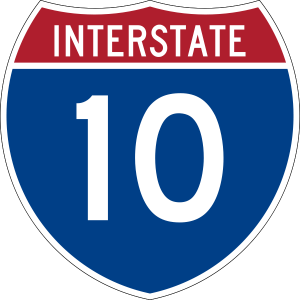This story was about the increase in the toll on the managed lanes of the Katy Freeway, but there was a tidbit at the end that caught my eye.
When officials started widening the freeway in 2003, at an eventual cost of $2.8 billion, their goal was to ease congestion in one of the area’s most clogged corridors.
The freeway then had 11 lanes and was carrying more than 2.5 times its capacity of 79,000 vehicles per day. Now with 20 lanes in some spots to flow traffic – including the managed lanes and frontage roads – the freeway can handle more vehicles, but demand is increasing as well.
In 2003, the average daily traffic count along I-10 at Wirt Road was 202,500, according to the Texas Department of Transportation. By 2011, the last year for which verified counts are available, the average traffic at Wirt was 274,600, a 35 percent increase.
[…]
Yet the freeway still isn’t as congested as it was prior to the widening, said Alan Clark, manager of transportation air quality programs for the Houston-Galveston Area Council.
“It is still vastly better than it was before,” Clark said. “Particularly it is easier to handle incidents. If there was an accident or problem on the freeway before the widening, the whole thing practically shut down.”
So the pre-expansion capacity of the Katy Freeway was 79,000 vehicles per day, and they basically doubled the number of lanes, what is the capacity today? I don’t know if you’d simply double that 79,000 per day figure, or if the math is more complicated than that. It sure would have had to go up quite a bit – like, almost four times as much – to stay ahead of that 274,000 vehicles per day average we’re seeing now. To say the least, I have my doubts about that. I sent an email to Chron reporter Dug Begley to ask about this, but he never replied. My point here is that way back when this expansion was still a twinkle in John Culberson’s eye, critics of the expansion were predicting that traffic levels would quickly rise to fill the extra capacity that was being built. Sure looks to me like they were right. No question, I-10 needed to be expanded, but where do we go from here? The design of the widened I-10 left no room for rail, further widening seems unlikely, and going up with a second deck or down with a tunnel would seem to be prohibitively expensive. Denser development with more and better transit is starting to look pretty good, isn’t it? Maybe we’ll have better luck with that next time.


It’s been a truism for years that as more lanes are added more cars will arrive to use them. Did the Texas DOT think it could bypass Parkinson’s Law?
I’ve been saying for years that sooner or later this issue would come to a head. As long as Houston keeps growing, there will be a need for more capacity, but many of our major highways have already reached the limits of their horizontal expansion. We’re already starting to see the tipping point with I-45, where they solicited opinions on expansion, and there was overwhelming opposition to grabbing more right-of-way. Vertical expansion above or below ground is incredibly expensive, and I suspect when they start throwing up figures for that kind of project, it may start making people stop and seriously consider how their transportation dollars are being spent.
When you are headed westbound, there is a reduction in lanes from 5 to 4 shortly after Eldridge until shortly after Highway 6. This single bottleneck nullifies much of the added capacity during the afternoon/evening rush. I’ve always been curious how they could spend $2.8 billion redeveloping an entire freeway and let that small portion back traffic up so far.
^^ And/or the concept of induced demand. http://www.worldbank.org/transport/roads/rpl_docs/apbinduc.pdf
In response to Jeff, there is room to have avoided that lane reduction. They put one or two of those towering lights up in a spot that prevented the freeway from keeping its width in that immediate area. The funny thing is that no one benefits more from that (or any other bottleneck…by design or not) than the companies that reside right there in the “Energy Corridor.” Or at least it would be “funny” if it wasn’t such a heaping load of BS that interferes with hundreds of thousands of people’s lives on a daily basis. Every day I drive around this town and observe that we are being played like a fiddle in so many ways from the oil/auto/construction industries (amongst others)…and it seems obvious to me that there is a lot of collusion going on between them.
Mr. Kuffner, observe your comment section, and then observe why transit seems so far off.
The westbound lane drop at Eldridge cited by Jeff makes room for the direct HOV/managed lane connector into the Addicks park and ride. The added lane, after SH 6, in turn, prevents the managed lanes from backing up, by giving them a lane add where they forced you back into the general purpose lanes.
This is geometrically sound and supports the express buses using the roadway. But in Paul’s mind, it’s a “heaping load of BS” and is probably a conspiracy on the part of Energy Corridor landowners, who are playing Paul (and others) “like a fiddle.”